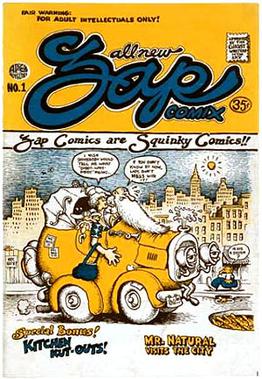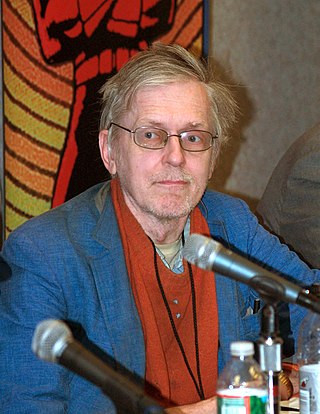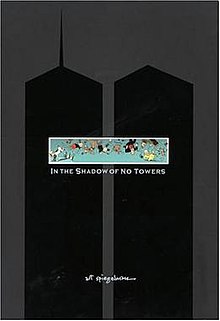
Underground comix are small press or self-published comic books that are often socially relevant or satirical in nature. They differ from mainstream comics in depicting content forbidden to mainstream publications by the Comics Code Authority, including explicit drug use, sexuality, and violence. They were most popular in the United States in the late 1960s and 1970s, and in the United Kingdom in the 1970s.

The Silver Age of Comic Books was a period of artistic advancement and widespread commercial success in mainstream American comic books, predominantly those featuring the superhero archetype. Following the Golden Age of Comic Books, the Silver Age is considered to cover the period from 1956 to 1970, and was succeeded by the Bronze Age.
A graphic novel is a long-form work of sequential art. The term graphic novel is often applied broadly, including fiction, non-fiction, and anthologized work, though this practice is highly contested by comics scholars and industry professionals. It is, at least in the United States, typically distinct from the term comic book, which is generally used for comics periodicals and trade paperbacks.

Itzhak Avraham ben Zeev Spiegelman, professionally known as Art Spiegelman, is an American cartoonist, editor, and comics advocate best known for his graphic novel Maus. His work as co-editor on the comics magazines Arcade and Raw has been influential, and from 1992 he spent a decade as contributing artist for The New Yorker. He is married to designer and editor Françoise Mouly and is the father of writer Nadja Spiegelman. In September 2022, the National Book Foundation announced that he would receive the Medal for Distinguished Contribution to American Letters.

Maus, often published as Maus: A Survivor's Tale, is a graphic novel by American cartoonist Art Spiegelman, serialized from 1980 to 1991. It depicts Spiegelman interviewing his father about his experiences as a Polish Jew and Holocaust survivor. The work employs postmodern techniques, and represents Jews as mice and other Germans and Poles as cats and pigs respectively. Critics have classified Maus as memoir, biography, history, fiction, autobiography, or a mix of genres. In 1992, it became the first and only graphic novel to win a Pulitzer Prize.
Justin Considine Green was an American cartoonist who is known as the "father of autobiographical comics." A key figure and pioneer in the 1970s generation of underground comics artists, he is best known for his 1972 comic book Binky Brown Meets the Holy Virgin Mary.

William Henry Jackson Griffith is an American cartoonist who signs his work Bill Griffith and Griffy. He is best known for his surreal daily comic strip Zippy. The catchphrase "Are we having fun yet?" is credited to Griffith.

Peter Sanderson Jr. is an American comic book critic and historian.

Franklin Robbins was an American comic book and comic strip artist and writer, as well as a prominent painter whose work appeared in museums including the Whitney Museum of American Art, where one of his paintings was featured in the 1955 Whitney Annual Exhibition of American Painting.

Françoise Mouly is a French-born American designer, editor and publisher. She is best known as co-founder, co-editor, and publisher of the comics and graphics magazine Raw (1980–1991), as the publisher of Raw Books and Toon Books, and since 1993 as the art editor of The New Yorker. Mouly is married to cartoonist Art Spiegelman, and is the mother of writer Nadja Spiegelman.
Bob Powell was an American comic book artist known for his work during the 1930–1940s Golden Age of comic books, including on the features "Sheena, Queen of the Jungle" and "Mr. Mystic". He received a belated credit in 1999 for co-writing the debut of the popular feature "Blackhawk". Powell also did the pencil art for the bubble gum trading card series Mars Attacks. He officially changed his name to S. Robert Powell in 1943.

Jay Patrick Lynch was an American cartoonist who played a key role in the underground comix movement with his Bijou Funnies and other titles. He is best known for his comic strip Nard n' Pat and the running gag Um tut sut. His work is sometimes signed Jayzey Lynch. Lynch was the main writer for Bazooka Joe comics from 1967 to 1990; he contributed to Mad, and in the 2000s expanded into the children's book field.

Tower of Shadows is a horror/fantasy anthology comic book published by the American company Marvel Comics under this and a subsequent name from 1969 to 1975. It featured work by writer-artists Neal Adams, Jim Steranko, Johnny Craig, and Wally Wood, writer-editor Stan Lee, and artists John Buscema, Gene Colan, Tom Sutton, Barry Windsor-Smith, and Bernie Wrightson.

Arie Kaplan is an American writer and comedian. He is the author of the book Masters of the Comic Book Universe Revealed!, and a writer for Mad magazine. He lives in New York City.

The Kin-der-Kids and Wee Willie Winkie's World were early newspaper comics by painter Lyonel Feininger and published by the Chicago Sunday Tribune during 1906–07.

Donald Richard Donahue was a comic book publisher, operating under the name Apex Novelties, one of the instigators of the underground comix movement in the 1960s.

Breakdowns is a collected volume of underground comic strips by American cartoonist Art Spiegelman. The book is made up of strips dating to before Spiegelman started planning his graphic novel Maus, but includes the strip "Maus" which presaged the graphic novel, and "Prisoner on the Hell Planet" which is reproduced in Maus. The original edition of 1977 is subtitled From Maus to Now; the expanded 2008 edition is subtitled Portrait of the Artist as a Young %@&*!.
The history of American comics began in the 19th century in mass print media, in the era of sensationalist journalism, where newspaper comics served as further entertainment for mass readership. In the 20th century, comics became an autonomous art medium and an integral part of American culture.

Comics Feature was an American magazine of news, criticism, and commentary pertaining to comic books, comic strips, and animation. Published by New Media Publishing, it produced 57 issues between 1980 and 1987.














